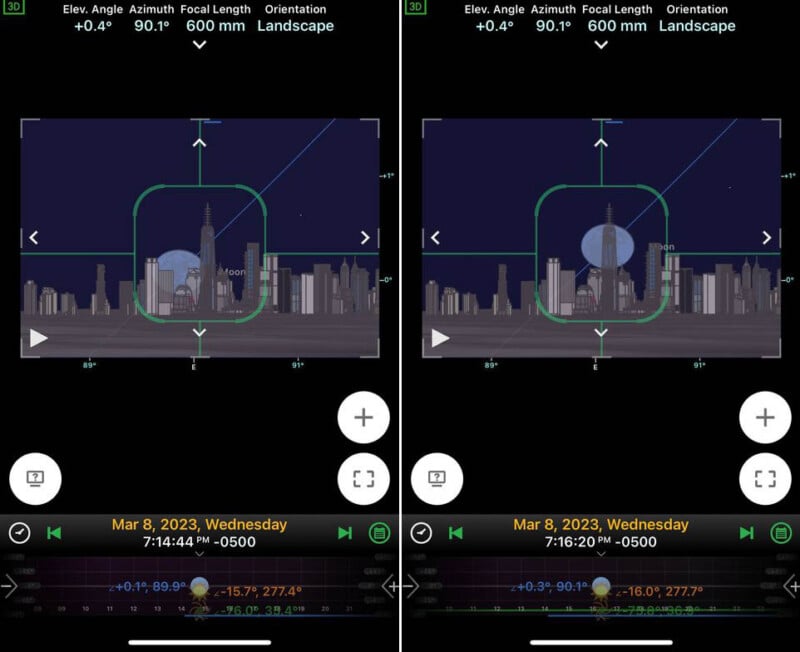Photographer’s Optical Illusion Photos Make the Moon Look Gigantic
![]()
Photographer Nina Wolfe shoots gorgeous photos using forced perspective to show the Moon illusion, the optical illusion that causes the Moon to look much larger when it’s closer to the horizon than when it’s higher in the sky.
“I had a dedicated dark room in the basement I never knew what to take pictures of, so my Dad gave me a 35mm cardboard slide with the transparency cut out; I walked around NYC holding up that square to find a good frame (those that know me, know that I still carry that piece of cardboard in my camera bag!)
“I bought postcards from gift shops in midtown Manhattan to give me ideas for pictures. I wandered through parks to capture street photography. During this time, I was shooting with my Dad’s Leica flex film camera which I still own.
“Sometimes with photography, one has to keep shooting until you develop a special love for a particular genre. Mine was landscapes, cityscapes, and my favorite… moon photography.”
Shooting a Moon Illusion Photo
Wolfe recently captured photos of a 97.8% waning gibbous Moon as it started to rise over NYC towards the One World Trade Center skyscraper, the tallest building in the United States.
![]()
![]()
The photos — both single exposures — were shot with the Nikon Z7 and Sigma 150-600mm lens at 600mm from 18 miles away.
When photographing the Moon with a telephoto lens from a great distance away from the subjects on the horizon, lens compression can produce a “giant moon” illusion.
The distance causes objects in the “foreground” (which are actually very far away) and the background (in this case, the Moon) to appear closer together than they actually are. Lens compression can cause the Moon to appear larger in the frame and closer to objects in the foreground or background, such as buildings, trees, or mountains.
“Why is the Moon so big in my images? The Moon is roughly a quarter million miles away, and any place you look at the Moon on Earth, it will be the same size,” Wolfe tells PetaPixel. “If you take a building such as One World Trade Center and you stand right next to it, it’s huge! You look at the same building from 15-20 miles away, it’s tiny.
“When you line up the moon behind One World Trade at 15-20 miles away, the moon will appear large and the building will be small. Why? Because the moon never changes size but Earth-bound objects (such as One World Trade, ESB, etc.) do change [apparent] size.
“How do you capture this illusion? Shoot with a long lens such as a 600 mm that magnifies the object. This will make the building look very close. Voila! You have captured the illusion.”
Wolfe’s moon illusion photos require a great deal of careful planning to ensure she is in the right place at the right time during a moonrise to achieve the compositions she has in mind.
“I use Planit Pro to plot my moon captures,” Wolfe tells PetaPixel. “When planning a moon shoot, weather and wind are what I look at first. My favorite weather app is Ventusky, which shows wind speed and low cloud cover. Low clouds is what I reference most.”

“My strategy exists of first determining whether clouds will block the view and then planning which location to shoot from if multiple locations and target buildings are available,” the photographer says. “Sometimes trees or power lines will block a lineup. I will travel to a location to see if moving to the right or left would help to achieve a similar capture.
“The slowest advisable shutter speed when shooting the moon is one second, which is my go-to starting point… any slower and you will start to get motion blur. I shoot in manual mode and with manual focus. I check to make sure my camera lens and camera body are always set to manual. I continually adjust the exposure during a moon shoot so that the moon does not get overexposed. This can be done via adjustment of the f/stop or shutter speed. I shoot with the lowest ISO possible.”
A Selection of Wolfe’s Moon Illusion Photos
Here are some more of Wolfe’s moon illusion photos in which the Moon looks unusually big next to things on the horizon:
![]()
![]()
![]()
![]()
![]()
![]()
![]()
![]()
![]()
![]()
![]()
“Photography has and always will be my passion and I love being able to share my passion with you,” Wolfe says.
You can find more of Wolfe’s work on her website and Instagram.
Image credits: Photographs by Nina Wolfe and used with permission